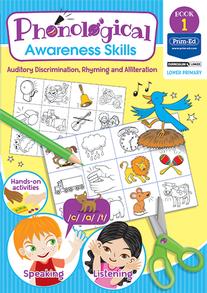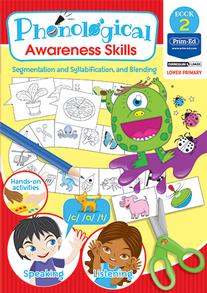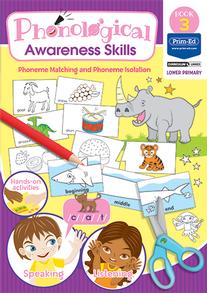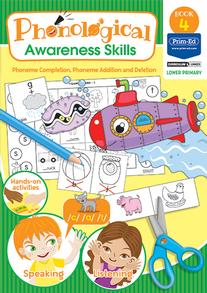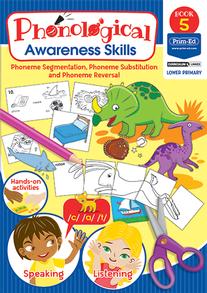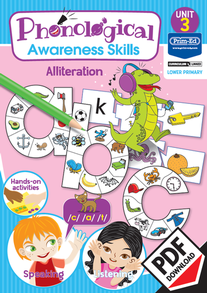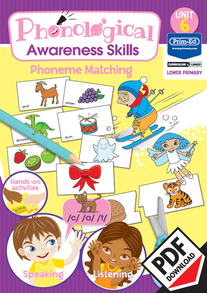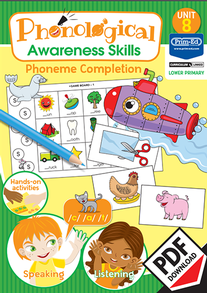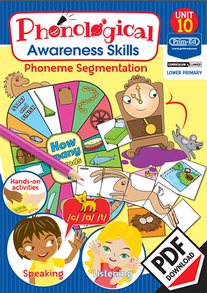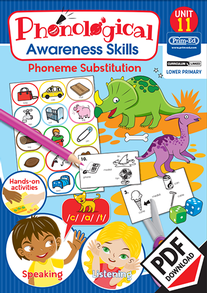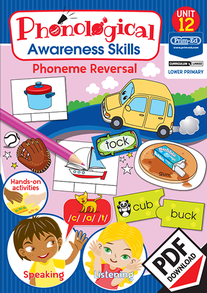-
0
Your cart is currently empty.
-
0
Your cart is currently empty.
Phonological Awareness Skills
Prim-Ed Publishing strives to provide high-quality learning resources for pupils and educators. Our comprehensive English resources cover topics including phonological awareness skills, phonics, oral literacy and the awareness of the sounds in words, syllables, and rhymes.
The Phonological Awareness Skills series was developed to assist early years teachers and parents to develop these important skills in their pupils and children.
Download a sample of Phonological Awareness Skills
What is the meaning of phonological awareness?
Phonological awareness is the ability to recognise that spoken language is made up of individual speech sounds and the capacity to manipulate single sounds (sound segments) of words and sentences. The general term phonological awareness encompasses phonemic awareness of sounds, words, syllables and rhyme.
When children are able to understand how different sounds come together in words, they can break down unfamiliar pronunciations into individual phonemes. This helps them work out what word is being said and teaches reading skills because it allows for more fluency when sounding out new letter combinations (phonetics).
Phonological awareness skills are the building blocks for a child learning to read.
Phonological awareness is important for pupils to learn
Phonological awareness is important because it provides a foundation for learning to read. In order to be able to read, a pupil needs to be able to understand that written words are made up of individual sounds and that these sounds can be manipulated. For example, the word 'bat' can be changed to 'pat' by replacing the /b/ sound with a /p/ sound.
When children are phonologically aware, they are more likely to be able to sound out new words they come across while reading. This is because they can break down these words into their component phonemes and then match them up with the correct letter or letters.
It also develops writing skills, as children need to be aware of the phonemes in order to spell words correctly.
What are phonemic awareness skills?
Phonemic awareness relates to phonemes, which are the smallest parts of sound.
Phonemic awareness is hearing the individual sounds or phonemes that make up spoken words. It is the ability to hear, identify these sounds and also manipulate phonemes (blend, segment, reverse or substitute these sounds) in words. As such, it is the foundation for learning how to read and spell words.
Importance of children becoming phonemically aware
Phonemic awareness skills are extremely important and a critical early childhood skill, which underlies all later learning in reading, spelling and writing. Children who have strong phonemic awareness skills are more likely to become good readers.
A child who has strong skills in this area will be able to read unfamiliar words quickly and accurately, as he or she will be able to sound out the word.
Children who have a strong phonemic awareness foundation are more likely to be successful in the five key elements of reading and literacy:
Sound and letter knowledge
- Phonemic awareness (sounds of language)
- Sounds and alphabet knowledge
Interpreting, analysing and evaluation
- Fluency
- Vocabulary
- Comprehension strategies
Prim-Ed’s Phonological Awareness Skills series
The five books in the Phonological Awareness Skills series have been designed to assist early years teachers to develop these important skills in their pupils.
The activities are predominantly speaking- and listening-based for four-year-olds but are also appropriate for pupils who struggle with sound-symbol correspondence, those beginning to read and older children who need support.
The twelve different skills in the books are presented in developmental order, so should be worked through from one to five, as children progress from basic to the most complex skills.
The books in the series include:
- Book 1: Auditory Discrimination, Rhyming and Alliteration
- Book 2: Segmentation and Syllabification, and Blending
- Book 3: Phoneme Matching and Phoneme Isolation
- Book 4: Phoneme Completion, and Phoneme Addition and Deletion
- Book 5: Phoneme Segmentation, Phoneme Substitution and Phoneme Reversal
Features of the Phonological Awareness Skills series resource
Each of the twelve skills has a number of components and the resources include games and activities focusing on sounds in spoken language. Some examples include:
- phonological activities that focus on the individual speech sounds in words
- phoneme isolation and segmenting activities
- phoneme blending and word building activities
- a variety of fun and engaging worksheets, games and puzzles
The series is designed to provide fun, interactive word games that support oral learning. Each book in the series includes:
- Teacher background information - provides teachers with tips on what they should look for when assessing this understanding in their pupils, as well an explanation of why these skills are necessary.
- Games and activities - activities, games and language play are fun ways to teach phonological skills to young children.
- Instructions - each game and activity is clearly explained with easy-to-understand teacher instructions. Tips are included for educators on how you can make the most out of each one.
- Assessment sheets - assessment sheets will provide you with a guide to assess each child’s understanding of the phonological skill.
- Assessments - a range of tests and assessments to help educators track children’s progress in phonological awareness
- Phonological worksheets - additional phonological and phonemic awareness activities and support worksheets if applicable.
- External resources - materials for each activity are included, as well as literature links and suggested websites.
- Photocopiable resources - a range of ready-to-use photocopiable resources ready to use in the classroom. Each unit is also available separately, as a full-colour PDF download.
The resources are perfect for younger children who need extension activities and older children who need remediation, consolidation, reinforcement or revision of skills.
How phonological awareness develops
Phonological awareness develops gradually over time. Young children first become aware of the individual speech sounds in words (phonemes) when they are able to distinguish between different sounds in words. They then learn to blend these sounds together to form words, and finally to break down words into their component phonemes.
Young children learn before they attend school, as phonological awareness develops through everyday experiences such as listening to and talking with family and friends.
Once children start school, their phonological skills can be further developed through explicit teaching.
Stages of phonological development
There are four main stages of phonological awareness development:
- Word
- Syllable
- Onset and Rime
- Phoneme
The following table shows the average age at which children typically reach each stage of phonological development:
| Age | Skill | Skill typically mastered |
|---|---|---|
| 4 | Auditory discrimination | |
| 4-5 | Rhyming | |
| 4-5 | Alliteration | |
| 4-5 | Segmentation and syllabification | » Sentence segmentation » Syllable segmentation |
| 5-6 | Blending | » Syllable blending » Phoneme blending (onset/rime) » Phoneme blending (all phonemes) |
| 5-6 | Phoneme matching | |
| 5-6 | Phoneme isolation | |
| 5-6 | Phoneme completion | |
| 6-7 | Phoneme addition and deletion | » Syllable deletion » Initial and final sound deletion |
| 6-7 | Phoneme segmentation | |
| 7-8 | Phoneme substitution | |
| 7-8 | Phoneme reversal |
The benefits of phonological and phonemic awareness
Research has shown that phonemic awareness is a better predictor of reading success than intelligence or reading experience.
It can also help children with their oral language development, in addition to reading and spelling. By being able to segment and blend sounds, children learn how to put together the sounds that make up a word. This is an important skill for learning to speak fluently.
There are many benefits to having a strong capability in this area of language. Some of these benefits include:
- improved basic reading skills
- ability to read quickly and fluently
- increased phonemic awareness in oral language
- ability to spell words correctly
- better comprehension of what is read
- improved writing capability
Teaching strategies for educators
Teaching phonological and phonemic awareness is important because these skills lay the foundation for later reading and spelling success.
There are many different ways that educators can help children develop their phonological and phonemic awareness. One of the most important things is to provide plenty of opportunities for children to engage in activities that develop these skills. Some specific strategies that educators can use include:
- providing words that rhyme for children to identify
- having children segment words into individual sounds
- having children blend sounds together to form words
- asking children how many syllables they hear in a word
- asking questions that require pupils to listen carefully to the spoken word and then respond
Phonological and phonemic awareness skills can also help children with their oral language development. By being able to segment and blend words, children learn how to put together the sounds that constitute words. This is an important skill for learning to speak fluently.
Phonological awareness activities and strategies
Phonemic and phonological awareness skills are important because they help children:
- Develop a strong foundation for learning to read and spell words correctly.
- Understand how spoken words are put together.
- Become more fluent readers and spellers.
Teaching young children phonological awareness is a gradual process. There are many strategies that can help children develop strong skills in this area.
Some of the best practices for teaching pupils to identify word sounds include:
- Introducing new concepts in a fun and interactive way.
- Providing opportunities for children to engage in hands-on activities.
- Encouraging children to think about words and sounds in different ways.
- Allowing time for practice and reinforcement.
- Reading aloud and rhyming is a great way to help children become aware of the individual sounds in spoken words and to help them develop phonemic awareness.
Phonological and phonemic awareness skills are essential for language and literacy success. The more competent a child is, the better reader he or she will become. In fact, research shows that phonemic awareness is a better predictor of reading success than intelligence. So it’s important for educators to focus on teaching these skills effectively.
Frequently asked questions
What is the difference between phonological awareness and phonics?
Phonics focuses on teaching children the specific letter-sound correspondences for reading. Phonemic awareness, on the other hand, is about teaching pupils how to identify and manipulate the individual sounds in words.
Can phonemic awareness be taught in formal education?
Yes! This can be taught in the classroom through phonemic awareness activities and explicit instruction.
What are some good phonemic awareness activities?
A few ideas for classroom-based phonemic awareness activities include:
- clapping out syllables
- segmenting spoken words into individual sounds
- deleting a sound from a word
- adding a sound to a word
- identifying onset (beginning sounds), medial and rime (end sounds)
What teachers can do to help at school?
There are many things that teachers can do to help develop phonemic awareness in their pupils. One way is to provide explicit instruction on how to identify and manipulate the individual word sounds.
Teachers can also provide opportunities for pupils to engage in phonemic awareness activities during school instruction.
It is important to introduce new concepts in a fun and interactive way. This will help children learn and remember the information better.
Does rhyming help children to learn phonics?
Yes. When teaching rhyming, begin with simple words and then gradually introduce more difficult ones. Using rhyming books and nursery rhymes, you can start by having children listen to two words and identify which one rhymes. Once they are comfortable with this task, ask them to find pairs of rhyming words. As they become better at rhyming, challenge them to come up with their own words that rhyme.
